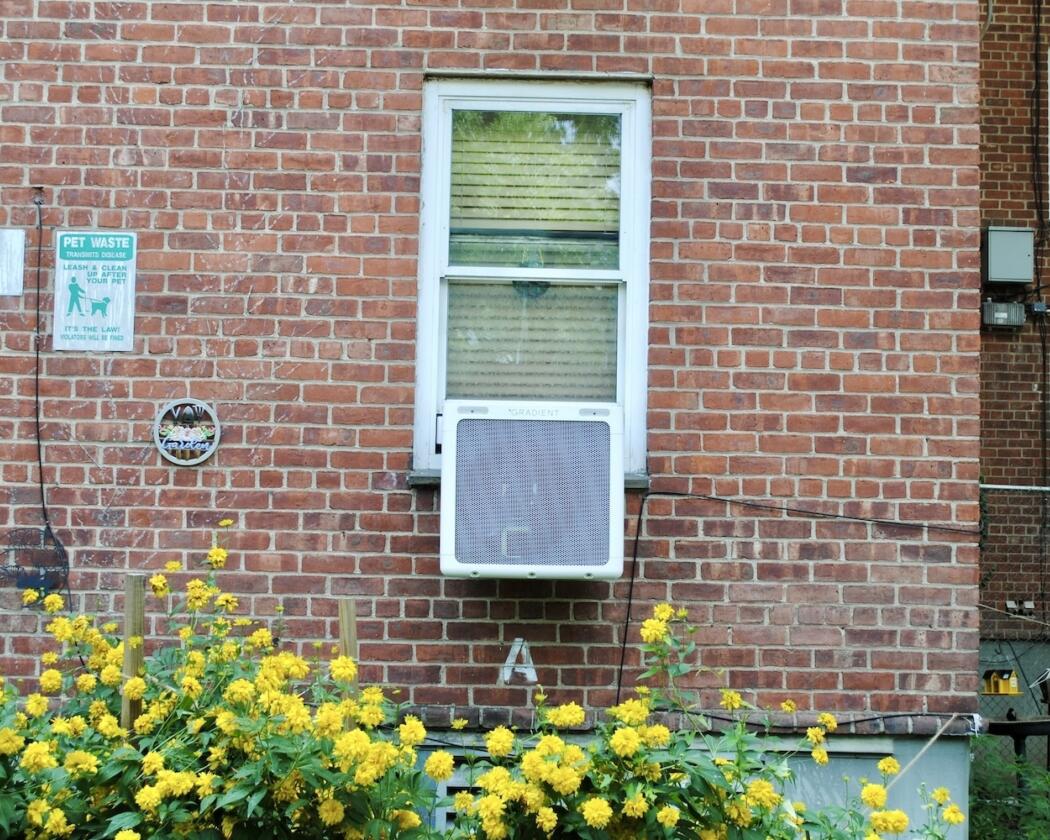
How do window-unit heat pumps work?
Behind the new heat pumps that are helping to decarbonize NYCHA’s Woodside housing
The new Gradient window unit heat pump is almost indistinguishable from a regular air conditioner — aside from the fact that it blocks much less of the view. Photo: Hannah Berman
From the outside, the sleek white boxes poking out of the windows of 24 apartments at Woodside Houses in Queens could easily be mistaken for any other air conditioner. But inside, the heat pumps that make up the heating and cooling pilot project have drastically improved residents’ comfort — and helped NYCHA to meet its greenhouse gas reduction goals.
The heat pumps installed in apartments throughout this development were the result of a 2022 city and state-funded industry competition to create a heating and cooling product that didn’t run on fossil fuels, was easy to install, and could be relatively affordable on a large scale. The winning manufacturers, Midea and Gradient, created versions of a heat pump unit that could be installed through a standard window, without the need for construction, drain piping, or system-wide electrical upgrades.
These smaller window units still work according to the same principles as other heat pumps: They extract heat from the outside air and move it into an apartment during the winter, and do the reverse in the summer, pulling heat from warm inside air and leaving the apartment cooled and comfortable.
Most heat pump technologies, like ductless mini-split heat pumps, are composed of a condenser that sits outside and an evaporator coil that sits inside, and refrigerant piping to connect them. Installing this equipment often requires cutting through walls and making major electrical upgrades, changes that would have been unworkable for Woodside Houses.
The smaller units created by Midea and Gradient, by contrast, shorten the gap between the “inside” and “outside” components of a heat pump — condenser, compressor evaporator, etc. — by putting all of them into one machine that sits on either side of a window sill. And they do it all on standard 120V power, so no electrical amperage upgrades were necessary.
Preliminary results from monitoring the performance of the electrical heat pumps show that they consume significantly less energy than a steam boiler. During the summer when the pumps were used to cool apartments, they slightly increased the buildings’ peak energy demand, but as time went on, the heat pumps saw a drop in daily electricity use compared to the old air conditioners they replaced.
In addition to energy use, the materials used in these heat pumps generate fewer greenhouse gases compared to traditional air conditioners. These new units use a much more eco-friendly refrigerant, compared to typical HVAC systems: R32, which has about one-third of the Global Warming Potential (GWP) than the more commonly used R410A, so should there be a leak in the heat pumps, the atmospheric damage is lessened. “If heat pumps start leaking refrigerant, you’ve negated a lot of the GHG reduction advantage,” Sahagian said. “[But] because these units are self-contained, the likelihood of a refrigerant leak during their operating lifetime is relatively small.”
While mini-split systems typically rely on one or two central units to serve an entire apartment, window heat pumps are room-specific — allowing for individual control, energy savings, and redundancy in the event of a malfunction.
A year following the initial installation in 2023, residents reported quieter, more consistent comfort and easier temperature control. Based on its popularity, and the emissions reductions that have come along with the new tech, NYCHA has committed to installing 30,000 more units over the next three years, starting with full deployment of Midea units at Woodside, to be completed prior to the 2025 – 2026 heating season. The program will then expand to cover the remaining buildings in the development.
And interest is growing beyond NYCHA. Energy consultants and the private buildings they work with are eyeing the units as a more scalable, less intrusive way to electrify older buildings. What started as a public housing experiment could end up transforming the retrofit market citywide.
